- Home
- Blog
- YouTube Videos
- Top Tips to Create Engaging YouTube Videos
Top Tips to Create Engaging YouTube Videos
Updated on June 1, 2025

Table of contents
- Tips for starting a YouTube Channel
- Video editing tips for YouTube
- Tips to grow your YouTube channel
- The title
- What is video keyword research?
- How to do keyword research on YouTube
- Improving your video’s Click-Through Rate (CTR)
- Add a number to the title of your video
- Include the current year in the title
- Craft a title that evokes strong emotions
- The description
- Use between 200 and 350 words
- Put the main keywords at the start of your description
- Explain the main value of your video in the description
- Optimize your video description for suggested videos
- The thumbnail
- Pay attention to resolution
- Use solid color backgrounds
- Don’t rely too much on text
- Avoid complex logos
- Try to include faces
- Closing Words
Whether you’re an online marketer trying to promote a business or just someone looking to share their message and passion with the world, there's no doubt that starting a YouTube channel in 2022 can feel intimidating. After years of being the #1 video website, the platform has become saturated with content creators that make high quality videos for pretty much any audience you can think of.
That being said, while making a name for yourself in between all the giants is not a quick or easy task, it’s definitely not an impossible one. The internet is filled with countless tips and resources on how to start, grow and boost your YouTube channel. We’ve read through all of them and decided to compile the best tips into a handy guide that both beginners and veterans will find useful.
So, without any further ado, let’s jump right into it:
Tips for starting a YouTube Channel
Find a niche and stick to it
A lot of content creators trying to grow a brand new channel feel tempted to make videos on multiple topics. After all, dipping your toes into multiple ponds sounds like a good way to attract a diverse audience and figure out what works and what doesn’t.
The truth, however, is that once you start getting you first subscribers, making videos on all kinds of wildly different topics is just going to drive away your audience.
If someone subscribed to your YouTube channel because of your great DIY tutorials, they’re not likely to enjoy watching you try out the latest Battle Royale game. If they enjoyed hearing your review of a brand new car, that doesn’t mean they care what you (or anyone else, for that matter) have to say about movies.
Making videos on topics that are wildly different from one another is, at best, going to result in less engagement from your subscribers and, at worst, drive people to unsubscribe.
If you’re trying to grow a successful channel, it’s a much better idea to pick a general theme and stick with it. Of course, that doesn’t mean you have to be super specific. For example, if most of your subscribers come from a Let’s Play video, that doesn’t mean you have to spend the rest of your YouTube career only playing that specific game.
You should try to diversify your content and keep an eye on trends within your specific niche. And if you do decide to expand in a different direction, make sure it’s something that most of your subscribers have an interest in.
Bring something unique to the table
Like we’ve said before, YouTube is already saturated with content creators. Chances are that no matter what your niche is, there are already many successful creators putting out videos for the same potential audience.
You’re competing for people’s attention against these established names. Copying them (or just creating a very similar type of content) won’t be enough if you want your channel to succeed. Instead, you should be trying to provide viewers with something unique that they can only get from you.
This can be anything from your personality to your expertise, your unique perspective on things, the depth of your research or your production/editing style. All that matters is that it’s unique to you and it’s strong enough to draw people in and keep them watching.
Have at least 50 video ideas ready before you start your channel
YouTube values a consistent upload schedule quite a lot. Depending on the type of content you make, you should try to upload at least one video per week, if not more.
Having videos planned in advance makes the whole process of weekly or daily video production much easier, but all the recording and editing can make it difficult to come up with new ideas.
That’s why you should start by writing down 50 (preferably 100) video ideas before you upload your first video. This way, you’ll always have a large pool of ideas to draw from when you need to start working on the next clip.
Of course, not all of these initial ideas are going to actually turn into videos, and that’s okay, because you’re definitely get new ideas to add to your list as you go along, helping you stay on top of your upload schedule.
Video editing tips for YouTube
Start your videos with a hook
Studies show that most people decide whether or not they’re going to watch a video in the first 15 seconds.
That’s why it’s important to make it immediately apparent what value your viewers are going to get from watching your clip, whether that’s learning something new or simply being entertained.
Consider the fact that half of all channels and videos on YouTube have a click-through rate (CTR) between 2% and 10%.
From the video title to the video description, it takes a lot of work to get people to click on one of your videos. On top of that, YouTube only counts clicks as views if the person watched more than 30 seconds of your clip, in order to prevent bots artificially boosting view numbers.
That means that you not only have to convince people to watch your video, you also have to keep them there for at least half a minute or more. Starting your video off with a logo or a long animated title sequence is a sure fire way to get people to back out of your clip.
The better approach would be to start your video off either by telling your viewers what they’re going to learn or by showing them a quick preview of something exciting that’s going to happen later on in your video.
This way, they can immediately see that your video is interesting and valuable to them, increasing the chances that they’ll stick around and watch it for longer.
And getting people to watch your video for longer is very important, not only because it increases your view count, but also because YouTube’s algorithm is much more likely to suggest and promote videos with a higher Audience Retention rate.

Use pattern interrupts
If people start drifting off and getting bored while watching your video, they’re more likely to end up clicking on one of YouTube’s suggested videos and leave without finishing your video.
That’s why it’s important to use so-called “pattern-interrupts” to disrupt any monotony in your clips and keep viewers constantly engaged.
This YouTube video editing tip is something you’ll need to keep in mind when cutting and recording your videos, since it involves using B-roll (so you can alternate between shots and make your videos more visually diverse and interesting), alternating camera angles and adding graphics and sound effects to your videos.
It can sound a little intimidating at first (and to be fair, it does involve a little more work than just having one shot with a voiceover playing over it), but YouTube is well past the days when you could get away with doing little to no editing to your clips.
Well produced videos are a must and with online video editing tools making it easy for anyone to cut, add B-roll and insert graphics, there’s no excuse for uploading monotonous, poorly edited clips.
Add background music to your videos
If your videos feature a lot of talking, especially between multiple people, adding some background music can help keep people engaged and fill out some awkward silences that might make viewers click away.
If you don’t want to record your own music tracks, you can just use stock music files. Either by subscribing to an online service like Audio Jungle or using an online editor like Flixier that comes with a built-in library of stock audio tracks free of charge.
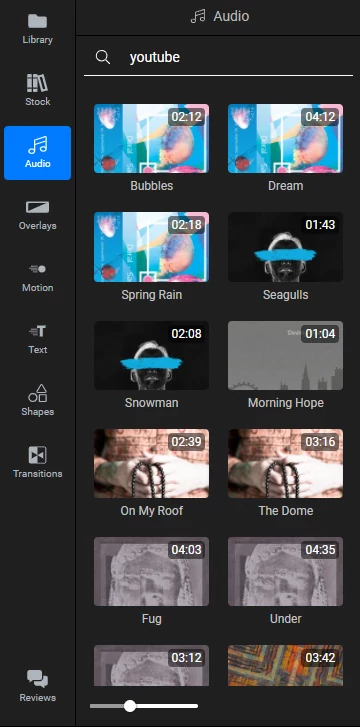
Be careful when using music in your videos though! It’s important that the track you choose matches the atmosphere and mood that you’re going for in the video.
You should also make sure that your music doesn’t make your voiceover difficult to understand. Make sure to lower the volume down to a reasonable level and use an equalizer to tone down the frequencies between 125Hz and 4000 Hz, since that is the range that tends to overlap with the human voice.

Cut out anything that’s unnecessary
Because YouTube tends to favor videos that are 10 minutes or longer, you might be tempted to pad out your clips in order to get a longer runtime. However, that wouldn’t be wise!
Longer clips aren’t going to do any better if they have a low Audience Retention rate. That means that a longer video still needs to keep people engaged and watching throughout most of its runtime in order to get suggested and pushed to the top of the search results.
Stuffing your videos full of irrelevant information and unnecessary talking just to reach that 10 minute mark will make people back out of the video or click on something else. If you want people to watch your videos until the end, the best way to do it is tight editing and cutting out anything that’s unnecessary!
Crop your videos for better framing
If you record in 4K, you can crop your videos down to improve framing and have them look more cinematic. The standard aspect ratio for landscape videos is 16:9. However, cropping your videos down to 19:9 can give them a more cinematic look. On top of that, your videos will also look a lot better on mobile, with modern phones adopting a “wider” aspect ratio where the screen is a lot taller. This means that your viewers will no longer have to put up with huge black bars when watching landscape mode. It also gives you a chance to fix your framing when cropping, in case you gave yourself too much headroom when setting up your shot.
Address people directly and add a Call to Action
Comments, likes, shares and subscribers gained are all things that YouTube looks at to determine whether or not your video is good.
Also known as “engagement signals”, these things tell YouTube that people have not only watched your video, but that your content resonated with them enough to make them engage with the YouTube platform, be it by participating in a discussion in the comments section or by clicking the Share button to show the video to their friends.
So, how do you get people to engage with your YouTube video? Well, other than making sure that the content itself is good, the best way to get people to engage with your video is to remind them using Calls to Action.
What are Calls to Action on YouTube?
Calls to Action are verbal or visual cues that encourage viewers to perform a certain action or set of actions. In our case, the Calls to Action would encourage people to like our video, share it with their friends and subscribe to our YouTube channel.
Verbal and visual Calls to Action
Adding a verbal Call to Action to your clip is pretty self-explanatory: just remind people to do it!
For visual Calls to Action, things can get a little trickier. When talking about YouTube videos, visual Calls to Action are usually little animations that pop up on screen to remind viewers to like the video and subscribe. They’re stylish and unobtrusive, making them perfect to use in the middle of a clip.
The only problem is that making your own Like and Subscribe animations can be difficult. Animation usually requires years of study and practice to get right, not to mention expensive software like Adobe After Effects.
Flixier fixes this issue by giving you a library of dozens of customizable motion graphics that you can add to your videos. No animation experience required! Just choose the one that you think looks best and drag it over to your video:

Addressing viewers directly
Another way to get your viewers to engage with your video is addressing them directly. Ask them to share their thoughts, opinions or experiences in the comments section. Whenever possible, check out what they answered and reply to them.
People love engaging with their favorite content creators and staying in touch with them via the comments is bound to turn them into loyal subscribers.
Tips to grow your YouTube channel
While it is true that making good content is still the number one factor in getting more views on YouTube, the truth is that with so many videos being uploaded every day, getting discovered on the world’s second largest search engine is no easy task.
That’s why in this chapter, we’re going to give you some tips and general guidelines aimed at maximizing the chances of your video ranking higher in the search results and showing up in the suggested videos section, in order to get you more views.
Obviously, these suggestions won’t magically get you views, but following them will drastically increase the chances of your videos succeeding. After all, what’s the point of spending so much time and effort on writing, recording and editing YouTube videos if they’re never going to get viewed by anyone because of bad SEO?
So, without further ado, let’s jump right into the YouTube SEO tips and tricks, starting with the first thing that YouTube asks you when for when uploading a new video:
The title
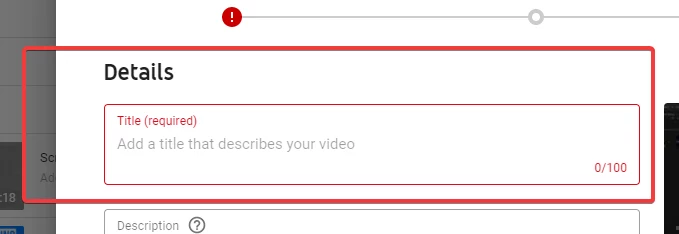
At first sight, deciding on a title for your YouTube video seems like a pretty straightforward task: just name the video based on what it’s about, right?
Well, yes and no. While it is true that video titles should always be representative of the video’s content, there’s a little more to it than that.
If you want to get as many views as possible on your video, you need to make sure that your video shows up in the YouTube search results (this is going to be a recurring theme throughout this chapter). And doing that is going to require a bit of keyword research.
What is video keyword research?
While the term may sound fancy, video keyword research just means figuring out the words that people use most often when looking videos up on YouTube.
This is important because if your video title contains more popular keywords, then it’s guaranteed to show up in more people’s search results, leading to more potential views.
Now, that doesn’t mean that you have to create your content around the most popular keywords. It means that phrasing your title in certain ways can result in more views for your videos.
How to do keyword research on YouTube
Doing keyword research on YouTube is often as simple as using the autofill suggestions in the search bar or looking at the search results for a given keyword.
Let’s say that you made a video on how to make tomato soup. Your main keyword for this video is obviously going to be “tomato soup”, and it’s obvious that you should include that in the title, but what about the rest?
Let’s type “tomato soup” into the search bar and see what the suggestions are:
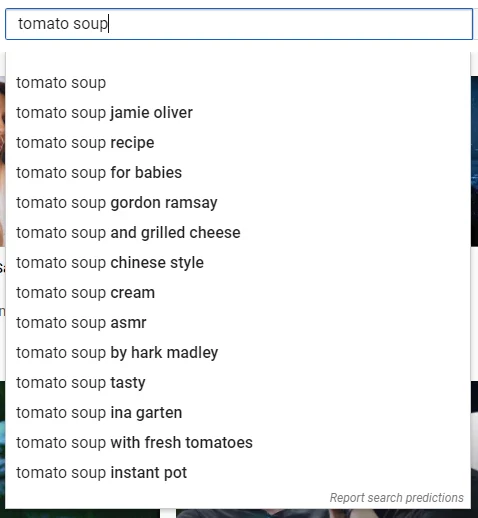
Just based on those, you can already see some ideas of what other words to include in your title, the most obvious one being “recipe” (although “Indian style”, “Chinese style” and “for babies” also seem to rank high and would make for good inclusions if they fit the content of your video).
Now, let’s press Enter and see what the top results are when searching for “tomato soup” on YouTube:
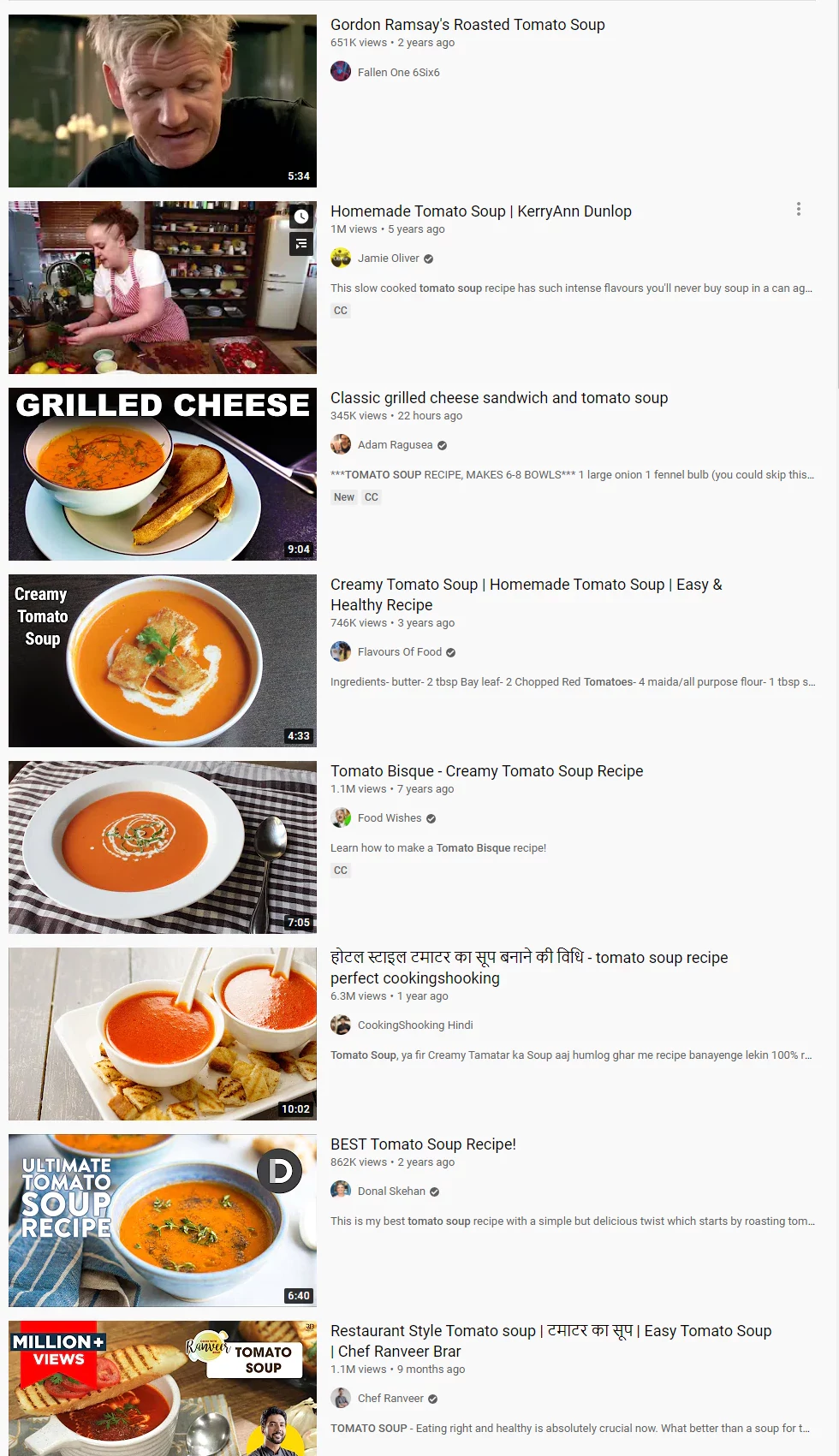
Notice how most of the results include the keywords “tomato soup” towards the beginning of the title and then sometimes even mention it again afterwards.
You should always try to have your keywords in the beginning of the title, if it makes sense!
Next, let’s look at what other words the top results have in common: “easy”, “homemade” and “how to make” all seem like popular choices.
Now that you’ve analyzed the search results, you can already figure out how to phrase your title. Something like “Tomato soup recipe — How to make an easy, homemade meal” is definitely going to rank higher than “how to prepare tomato soup”.
Obviously, you could have just arrived at that first title on your own since the subject of tomato soups is not necessarily all that nuanced, but it’s always better to do your research and formulate titles based on that in order to make sure that your YouTube videos get as many views as possible.
Now that we’ve figured out how to make a video title that appears in the search results, let’s move on to the next thing:
Improving your video’s Click-Through Rate (CTR)
The clickthrough-rate (often shortened to CTR) represents the percentage of people that click on your video after being presented with it in their search results, on their YouTube homepage or in the suggested videos section.
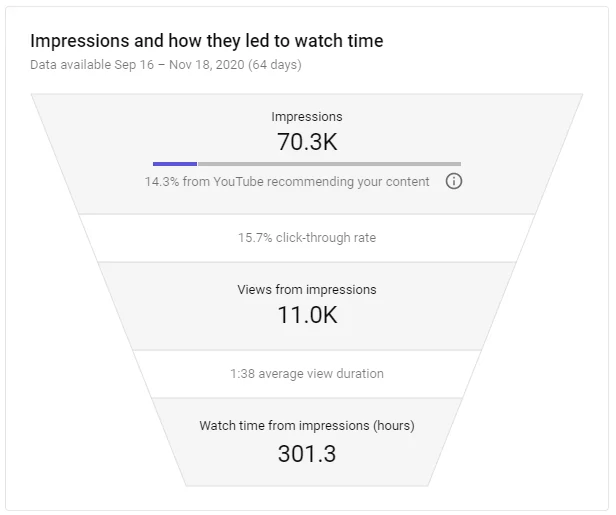
Since your video’s title (along with the thumbnail) is the first thing someone sees when deciding whether or not to click on your video, it’s important that you have a title which can get you those clicks.
Add a number to the title of your video
A common tip that works for both YouTube videos as well as articles and blog posts is to add a number to your title (if it makes sense to, of course).
Time and time again, research has shown that people are more likely to click on titles which contain numbers, which can also explain the popularity of listicles and “top 10 “ videos.
Include the current year in the title
Expanding on that, you should try to include the current year in the title as well, if it makes sense for you to do so.
If you’re making a software tutorial, for example, people are more likely to click on a video that has the current year in the title since they’ll know the person making it is using the latest version of the software (whereas older videos might be outdated due to interface or functionality changes).
Craft a title that evokes strong emotions
Another tip to increase your YouTube video’s CTR is to use a title that grabs the viewer’s attention and evokes a strong emotion. If your title promises a sad, happy or surprising/exciting story, people are a lot more likely to click on it, but remember: clickbait is bad for your channel.
A person that feels misled by your title is either going to stop watching your video early or worse, dislike your video.
People leaving your videos early on will make your Audience Retention plummet and cause YouTube to stop recommending your videos. The same is true for a bad likes to dislikes ratio.
That’s not to mention that no reputable brand is going to associate its image with cheap, clickbait-y content. So, if you want to have a successful YouTube channel, always remember the golden rule: the title must be representative of the video.
The description
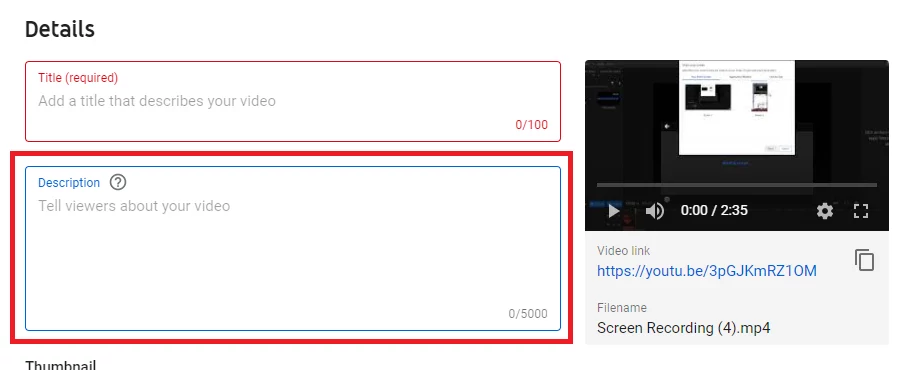
A lot of content creators tend to treat them as an afterthought, but in reality, YouTube video descriptions play a huge role in getting you more views by helping your video show up in search results and drawing people in.
Use between 200 and 350 words
Most experts suggest that the YouTube video description should be at least 200 words long, with 300 - 350 being the optimal length.
Put the main keywords at the start of your description
Just like with the titles, YouTube themselves recommend that you put the main keywords towards the beginning of your description.
The beginning part of your description is also very important when it comes to increasing the click-through rate of your video by drawing people in. The first 100 characters of your description will show up in the YouTube search results, along with the title and thumbnail of your video.

The first 2-3 sentences need to present people with the value they would gain from watching your video, in order to entice them into clicking. Once again, you need to be smart about ‘selling’ your video, but don’t be deceiving. Dishonest descriptions can hurt your video performance, channel and brand image just as much as a clickbait title.
Explain the main value of your video in the description
Moving past the first 2 to 3 sentences, you should use the rest of your description to describe what your video is about.
You might think nobody will read it, but a lot of people scroll down and click the Show More button to skim the description during the first seconds of your video and decide whether or not to keep watching.
Having a solid summary of your video will prove to them that your content is valuable and keep them engaged with your video for longer.
Optimize your video description for suggested videos
It’s also important to keep keywords in mind while writing the main body of your description. YouTube will still take them into account even though they won’t weigh as much as the ones in the first part, and they’ll still increase the chances of your video ranking high in the search results or getting suggested.
In fact, you might even want to check out some of your competitors’ successful videos that are in the same niche and deal with the same topic and try copying some of the keywords from their descriptions, if they fit. This will increase the chances of your video showing up in the suggested videos column next to theirs. If their video gets a lot of views, yours might end up getting some clicks as well!
That being said though, make sure you don’t overdo it with the keywords. Your description should make sense. If someone who has no idea what your channel is about can understand what the content of your video is based solely on the description, then it means you’ve done a good job writing it.
If possible, we would also suggest writing it in a light, conversational tone.
Oh, and even though getting keywords from competitors’ videos is perfectly fine, you should never copy someone else’s description.
Not only is it bad form, it will also severely hurt the chances of your video getting a lot of views.
And that’s not just us saying it! YouTube themselves have stated this: “Be sure each video has a unique description; this makes it easier to find through search, and helps it stand out from similar videos.”
That’s it for descriptions. If writing a good description still feels a little daunting, don’t worry! Practice makes perfect and you’ll get better at writing them in no time.
The thumbnail
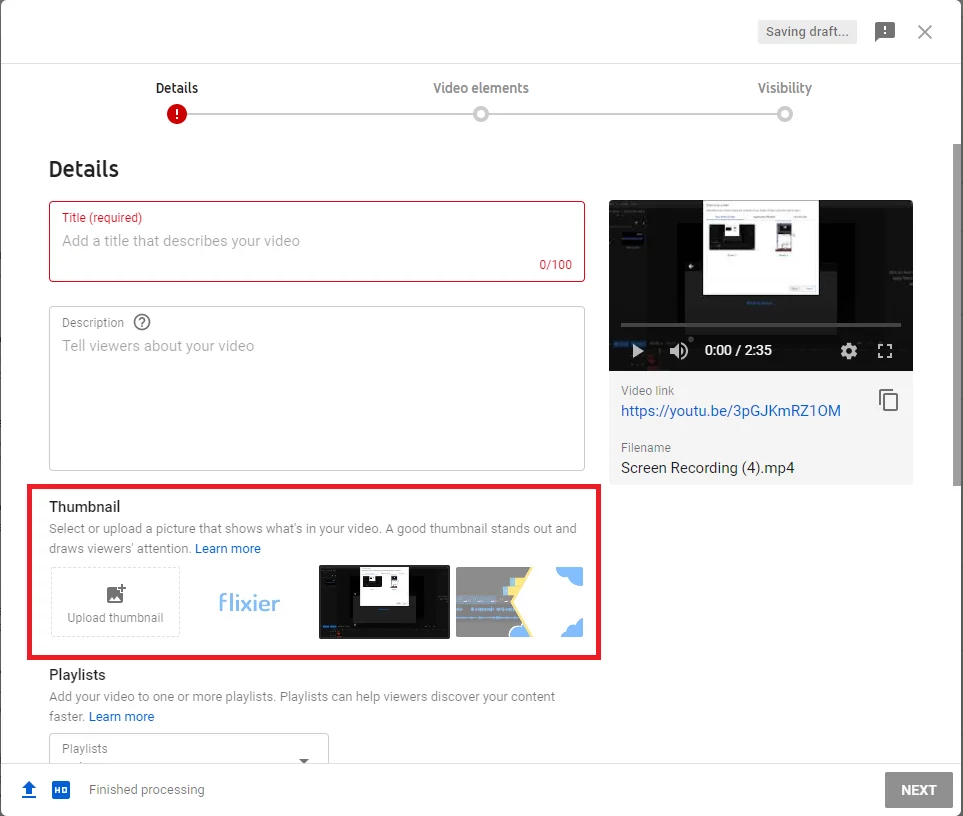
Given that they take up the most space on the screen, thumbnails are the main thing that people take into account when deciding whether or not to click on your video.
As opposed to the title and description, however, thumbnails are only meant to appeal to the human element, not YouTube’s search algorithm.
This makes the task of creating an effective thumbnail a little more subjective, although there are still some guidelines that you can follow to increase your chances of success.
The main thing to keep in mind here is that your video thumbnails need to pop. Most of the time, your video will only appear to people in a sea of other clips, so you need to make sure that your thumbnail sets it apart from the crowd.
Pay attention to resolution
Start with the correct sizing and proportions to make sure your thumbnails look professional.
According to YouTube's guidelines, your thumbnail image should be 1280 x 720 pixels in size, with a minimum width of 640 pixels. And a ratio of 16:9 is the most suitable.
It's a huge mistake to make a thumbnail picture that is too small. If anything, you should choose a bigger picture size that can be scaled down rather than a smaller image size that will end up stretched and distorted.
Use solid color backgrounds
Solid colors work best! Red, green, yellow and blue are considered to be the best colors to use as a background!
Don’t rely too much on text
Text should be kept to a minimum. That’s what the title is for! If you do include text, make sure to make the letters big, since thumbnails tend to be pretty tiny, even when viewed on large screens.
Avoid complex logos
Branding is fine, but you should try to do it via the colors and overall design, rather than logos. If you do include your logo, make sure to keep it simple and discernable.

Try to include faces
Lastly, human faces displaying strong emotions (such as fear, sadness, happiness and excitement) usually get a lot of clicks, too. They’re a surefire way to increase your overall views, but whether or not using those sorts of thumbnails is something you should do depends a lot on whether it fits with your brand and the content of the videos.
Which brings us back to the golden rule: make sure your thumbnails are representative of your videos!
Just like with titles and descriptions, a deceiving thumbnail will make people back out of your video really quickly, bringing down your audience retention (or even messing up your likes and dislikes ratio).
Closing Words
We hope you found this guide helpful and wish you good luck in your future YouTube career!
Dan is passionate about all things tech. He’s always curious about how things work and enjoys writing in-depth guides to help people on their content creation journey.


